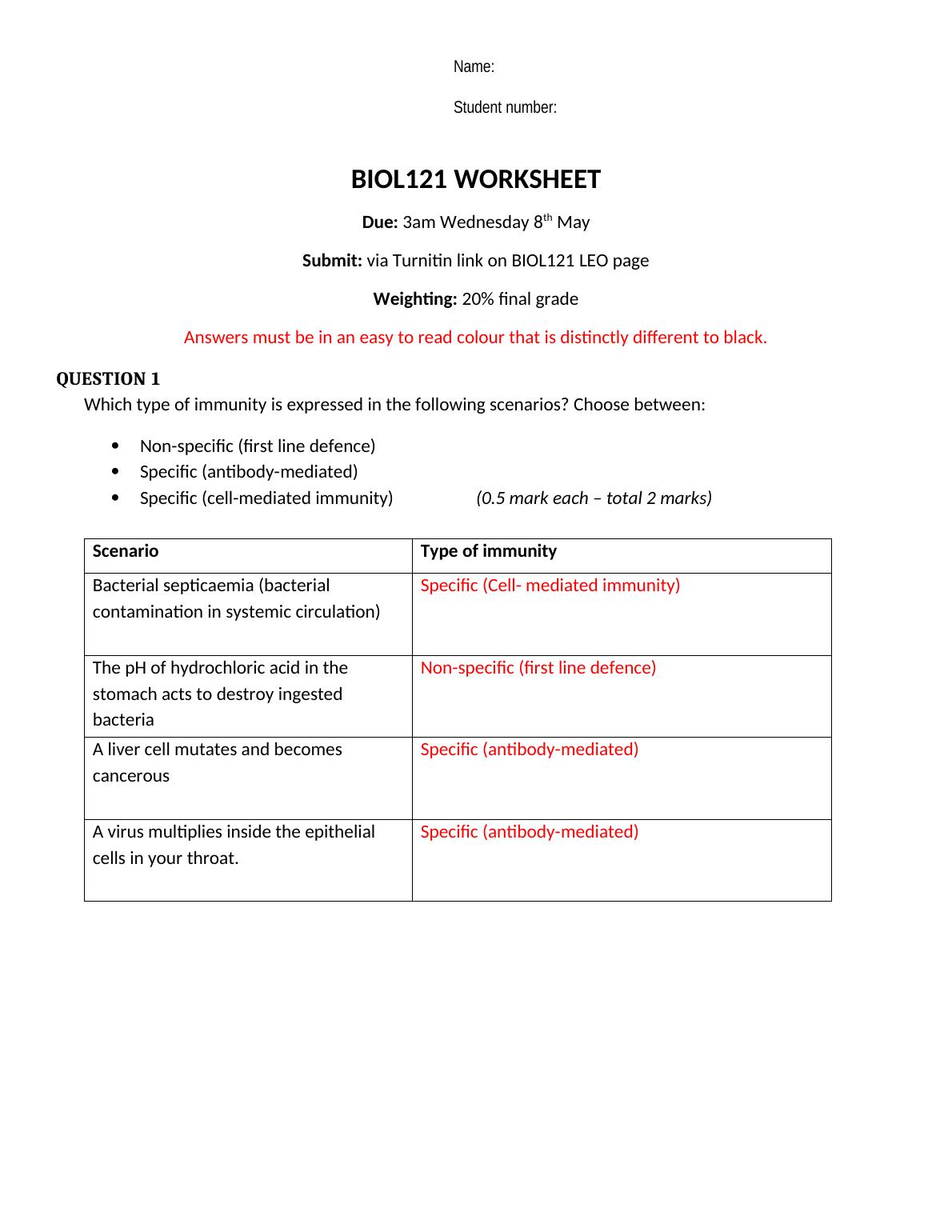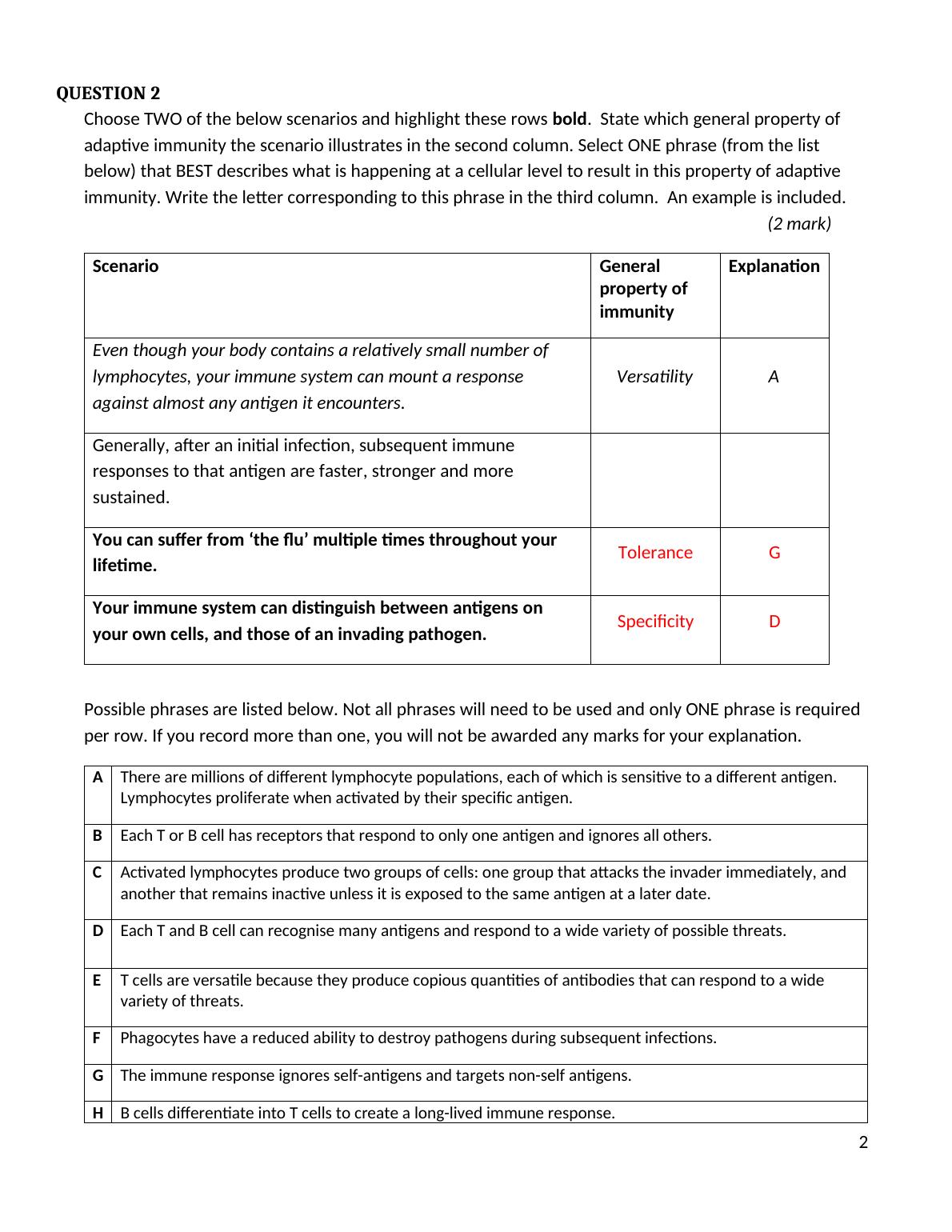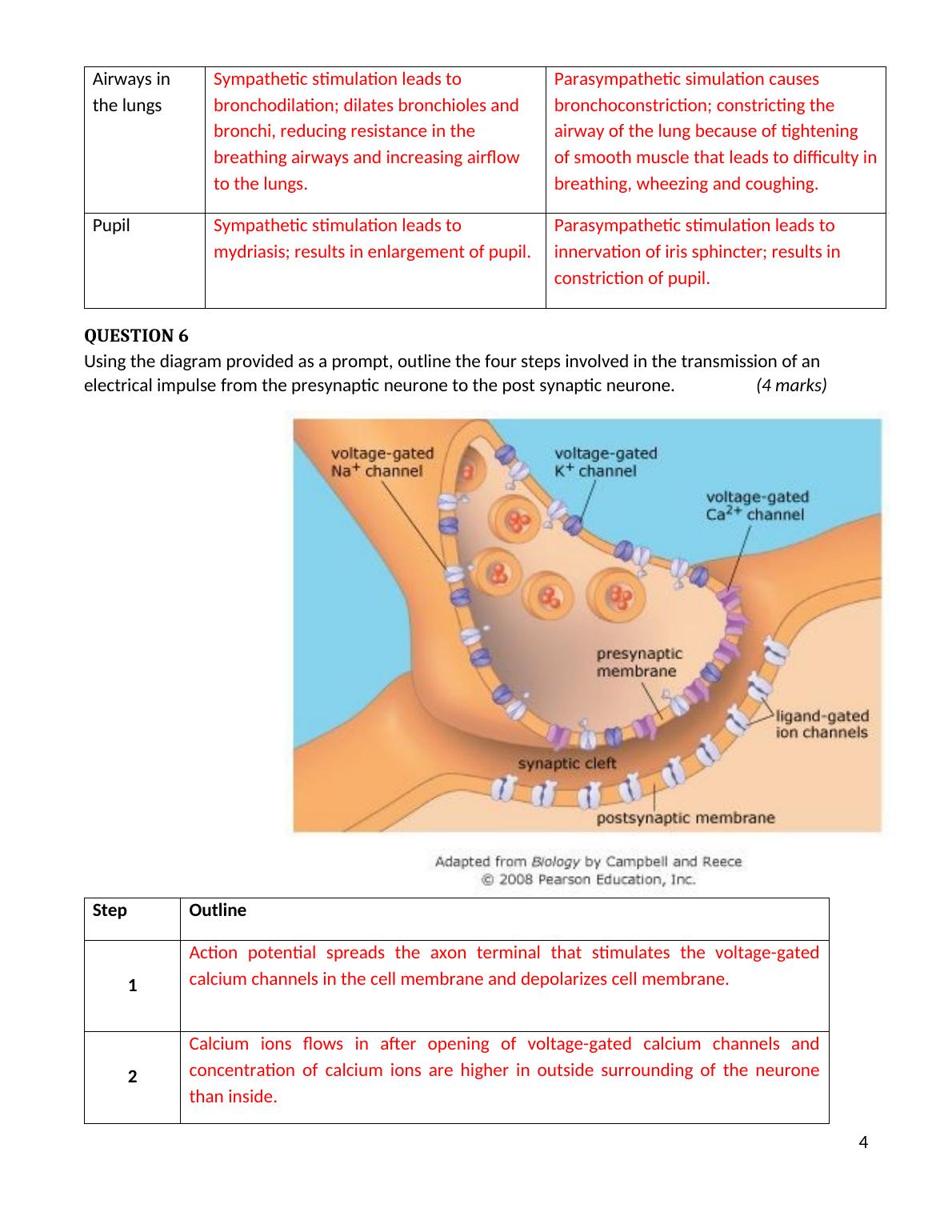Role of Baroreceptors in Blood Pressure Control
Added on 2022-12-15
17 Pages4024 Words467 Views
Name:
Student number:
BIOL121 WORKSHEET
Due: 3am Wednesday 8th May
Submit: via Turnitin link on BIOL121 LEO page
Weighting: 20% final grade
Answers must be in an easy to read colour that is distinctly different to black.
QUESTION 1
Which type of immunity is expressed in the following scenarios? Choose between:
Non-specific (first line defence)
Specific (antibody-mediated)
Specific (cell-mediated immunity)
(0.5 mark each – total 2 marks)
Scenario Type of immunity
Bacterial septicaemia (bacterial
contamination in systemic
circulation)
Specific (Cell- mediated immunity)
The pH of hydrochloric acid in
the stomach acts to destroy
ingested bacteria
Non-specific (first line defence)
A liver cell mutates and
becomes cancerous
Specific (antibody-mediated)
A virus multiplies inside the
epithelial cells in your throat.
Specific (antibody-mediated)
Student number:
BIOL121 WORKSHEET
Due: 3am Wednesday 8th May
Submit: via Turnitin link on BIOL121 LEO page
Weighting: 20% final grade
Answers must be in an easy to read colour that is distinctly different to black.
QUESTION 1
Which type of immunity is expressed in the following scenarios? Choose between:
Non-specific (first line defence)
Specific (antibody-mediated)
Specific (cell-mediated immunity)
(0.5 mark each – total 2 marks)
Scenario Type of immunity
Bacterial septicaemia (bacterial
contamination in systemic
circulation)
Specific (Cell- mediated immunity)
The pH of hydrochloric acid in
the stomach acts to destroy
ingested bacteria
Non-specific (first line defence)
A liver cell mutates and
becomes cancerous
Specific (antibody-mediated)
A virus multiplies inside the
epithelial cells in your throat.
Specific (antibody-mediated)

QUESTION 2
Choose TWO of the below scenarios and highlight these rows bold. State which
general property of adaptive immunity the scenario illustrates in the second
column. Select ONE phrase (from the list below) that BEST describes what is
happening at a cellular level to result in this property of adaptive immunity. Write
the letter corresponding to this phrase in the third column. An example is
included.
(2 mark)
Scenario General
property
of
immunity
Explana
tion
Even though your body contains a relatively small
number of lymphocytes, your immune system can
mount a response against almost any antigen it
encounters.
Versatility A
Generally, after an initial infection, subsequent
immune responses to that antigen are faster,
stronger and more sustained.
You can suffer from ‘the flu’ multiple times
throughout your lifetime. Tolerance G
Your immune system can distinguish between
antigens on your own cells, and those of an
invading pathogen.
Specificity D
Possible phrases are listed below. Not all phrases will need to be used and only
ONE phrase is required per row. If you record more than one, you will not be
awarded any marks for your explanation.
A There are millions of different lymphocyte populations, each of which is sensitive to a
different antigen. Lymphocytes proliferate when activated by their specific antigen.
B Each T or B cell has receptors that respond to only one antigen and ignores all
others.
C Activated lymphocytes produce two groups of cells: one group that attacks the
invader immediately, and another that remains inactive unless it is exposed to the
same antigen at a later date.
D Each T and B cell can recognise many antigens and respond to a wide variety of
possible threats.
E T cells are versatile because they produce copious quantities of antibodies that can
2
Choose TWO of the below scenarios and highlight these rows bold. State which
general property of adaptive immunity the scenario illustrates in the second
column. Select ONE phrase (from the list below) that BEST describes what is
happening at a cellular level to result in this property of adaptive immunity. Write
the letter corresponding to this phrase in the third column. An example is
included.
(2 mark)
Scenario General
property
of
immunity
Explana
tion
Even though your body contains a relatively small
number of lymphocytes, your immune system can
mount a response against almost any antigen it
encounters.
Versatility A
Generally, after an initial infection, subsequent
immune responses to that antigen are faster,
stronger and more sustained.
You can suffer from ‘the flu’ multiple times
throughout your lifetime. Tolerance G
Your immune system can distinguish between
antigens on your own cells, and those of an
invading pathogen.
Specificity D
Possible phrases are listed below. Not all phrases will need to be used and only
ONE phrase is required per row. If you record more than one, you will not be
awarded any marks for your explanation.
A There are millions of different lymphocyte populations, each of which is sensitive to a
different antigen. Lymphocytes proliferate when activated by their specific antigen.
B Each T or B cell has receptors that respond to only one antigen and ignores all
others.
C Activated lymphocytes produce two groups of cells: one group that attacks the
invader immediately, and another that remains inactive unless it is exposed to the
same antigen at a later date.
D Each T and B cell can recognise many antigens and respond to a wide variety of
possible threats.
E T cells are versatile because they produce copious quantities of antibodies that can
2

respond to a wide variety of threats.
F Phagocytes have a reduced ability to destroy pathogens during subsequent
infections.
G The immune response ignores self-antigens and targets non-self antigens.
H B cells differentiate into T cells to create a long-lived immune response.
QUESTION 3
Describe how bone cells respond to the hormones involved in the homeostasis of
blood calcium ion concentration.
(3 marks)
Calcium released from the bone is controlled by parathyroid hormone. In order to
maintain the blood calcium homeostasis, the endocrine system play as a control
centre and any alternation in the level of blood calcium will exhibit following
effects like in case of low blood calcium level, parathyroid hormone will be
secreted by the parathyroid gland, which will cause the effector organs like bones
and kidney to respond (Blaine, Chonchol & Levi, 2015). Calcitriol controls
phosphorus and calcium level in the blood, which will maintain a fit skeletal
system. Osteoclasts result in bone resorption that releases calcium in the blood
stream, which in turn controls calcium homeostasis.
QUESTION 4
Why is injury to the medulla oblongata usually fatal?
(2 marks)
Medulla oblongata is situated in the lower portion of the brain and carry out
various involuntary actions like controlling heartbeat, breathing and swallowing.
Any kind of damage to medulla oblongata is serious because it is considered as the
crucial part of brain, hence any injury to medulla oblongata will affect the brain’s
involuntary actions that is necessary for survival (Wu & Xu, 2016). Medulla
oblongata also function as a kind of pathway for messages from different portions
of the brain to the spinal cord.
QUESTION 5
Complete the following table summarising the effects of autonomic innervation on
target tissues. You must include both the effect upon the target tissue and a
consequence of this stimulation in your answer.
The first row has been completed as an example. (1 mark/box; 4 marks total)
3
F Phagocytes have a reduced ability to destroy pathogens during subsequent
infections.
G The immune response ignores self-antigens and targets non-self antigens.
H B cells differentiate into T cells to create a long-lived immune response.
QUESTION 3
Describe how bone cells respond to the hormones involved in the homeostasis of
blood calcium ion concentration.
(3 marks)
Calcium released from the bone is controlled by parathyroid hormone. In order to
maintain the blood calcium homeostasis, the endocrine system play as a control
centre and any alternation in the level of blood calcium will exhibit following
effects like in case of low blood calcium level, parathyroid hormone will be
secreted by the parathyroid gland, which will cause the effector organs like bones
and kidney to respond (Blaine, Chonchol & Levi, 2015). Calcitriol controls
phosphorus and calcium level in the blood, which will maintain a fit skeletal
system. Osteoclasts result in bone resorption that releases calcium in the blood
stream, which in turn controls calcium homeostasis.
QUESTION 4
Why is injury to the medulla oblongata usually fatal?
(2 marks)
Medulla oblongata is situated in the lower portion of the brain and carry out
various involuntary actions like controlling heartbeat, breathing and swallowing.
Any kind of damage to medulla oblongata is serious because it is considered as the
crucial part of brain, hence any injury to medulla oblongata will affect the brain’s
involuntary actions that is necessary for survival (Wu & Xu, 2016). Medulla
oblongata also function as a kind of pathway for messages from different portions
of the brain to the spinal cord.
QUESTION 5
Complete the following table summarising the effects of autonomic innervation on
target tissues. You must include both the effect upon the target tissue and a
consequence of this stimulation in your answer.
The first row has been completed as an example. (1 mark/box; 4 marks total)
3

Target
tissue
Effect of sympathetic
stimulation
Effect of parasympathetic
stimulation
Contractile
force of
the heart
Contractile force increases; more
blood pumped from heart
No parasympathetic innervation
of ventricular myocardium;
therefore, no result
Airways in
the lungs
Sympathetic stimulation leads to
bronchodilation; dilates
bronchioles and bronchi, reducing
resistance in the breathing
airways and increasing airflow to
the lungs.
Parasympathetic simulation
causes bronchoconstriction;
constricting the airway of the lung
because of tightening of smooth
muscle that leads to difficulty in
breathing, wheezing and
coughing.
Pupil Sympathetic stimulation leads to
mydriasis; results in enlargement
of pupil.
Parasympathetic stimulation leads
to innervation of iris sphincter;
results in constriction of pupil.
QUESTION 6
Using the diagram provided as a prompt, outline the four steps involved in the
transmission of an electrical impulse from the presynaptic neurone to the post
synaptic neurone.
(4 marks)
Step Outline
1
Action potential spreads the axon terminal that stimulates the
voltage-gated calcium channels in the cell membrane and
depolarizes cell membrane.
2
Calcium ions flows in after opening of voltage-gated calcium
channels and concentration of calcium ions are higher in outside
surrounding of the neurone than inside.
3
Influx of calcium ions activates synaptic vesicles, by allowing them
to fuse with axon-terminal membrane in order to discharge
neurotransmitter.
4 Neurotransmitter gets attached to the receptors proteins on the
target cell (post synaptic cell).
4
tissue
Effect of sympathetic
stimulation
Effect of parasympathetic
stimulation
Contractile
force of
the heart
Contractile force increases; more
blood pumped from heart
No parasympathetic innervation
of ventricular myocardium;
therefore, no result
Airways in
the lungs
Sympathetic stimulation leads to
bronchodilation; dilates
bronchioles and bronchi, reducing
resistance in the breathing
airways and increasing airflow to
the lungs.
Parasympathetic simulation
causes bronchoconstriction;
constricting the airway of the lung
because of tightening of smooth
muscle that leads to difficulty in
breathing, wheezing and
coughing.
Pupil Sympathetic stimulation leads to
mydriasis; results in enlargement
of pupil.
Parasympathetic stimulation leads
to innervation of iris sphincter;
results in constriction of pupil.
QUESTION 6
Using the diagram provided as a prompt, outline the four steps involved in the
transmission of an electrical impulse from the presynaptic neurone to the post
synaptic neurone.
(4 marks)
Step Outline
1
Action potential spreads the axon terminal that stimulates the
voltage-gated calcium channels in the cell membrane and
depolarizes cell membrane.
2
Calcium ions flows in after opening of voltage-gated calcium
channels and concentration of calcium ions are higher in outside
surrounding of the neurone than inside.
3
Influx of calcium ions activates synaptic vesicles, by allowing them
to fuse with axon-terminal membrane in order to discharge
neurotransmitter.
4 Neurotransmitter gets attached to the receptors proteins on the
target cell (post synaptic cell).
4

End of preview
Want to access all the pages? Upload your documents or become a member.
Related Documents
Questions and Answers - BIOL121lg...
|17
|3542
|279
BIOL121 Worksheet: Immunity, Bone Cells, Muscle Contraction, Urine Formationlg...
|17
|3838
|84
Role of Bone Cells in Homeostasis of Blood Calcium Ion Concentrationlg...
|14
|3290
|57
BIOL121 Worksheetlg...
|13
|3457
|345
Role of Baroreceptors in Blood Pressure Controllg...
|16
|3461
|44
Solution Paper Questions 2022lg...
|21
|3688
|28
